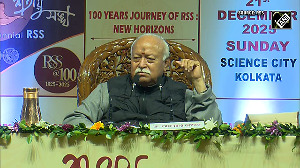Dilip D'Souza has been 'overwhelmed' by the poverty he saw during some of his recent train trips. And he's not persuaded by 'figures' pointing otherwise, especially those that compare India's poverty before and after liberalisation.
Let me see if I can persuade Dilip (and other readers) without using numbers as crutches. His observations make for interesting anecdotal evidence and I won't counter that. Instead I would add my own observations.
When I was a boy, seeing people walk about barefoot was common. I remember asking my mother's aunt (who used to help take care of me) "Why don't these people wear shoes or slippers?" and she'd shush me up, a bit embarrassed.
Today as I walk down the same roads of my childhood (my current office is located on a road parallel to where my grandaunt lived), I have to strain to see someone barefoot. I actually took a walk yesterday around those lanes of Grant Road just to check that out and I could not find even a single barefooted person.
Even the poorest labourers at a construction site wore rubber Hawaii chappals. This is not true just in Bombay. I've observed it during my trips to Pune, Bangalore, Delhi, Kolkatta, and across Madhya Pradesh. Even the poorest have some sort of footwear. Being barefoot was common twenty years back. It's not any longer. People can afford slippers, fancy sandals and shoes. Shoes! Look around. You'd see more people decently shod today than at any other time in the past that I remember.
I also see many more poor people using public transport. Twenty years back our maids would walk two kilometres. Today they catch the bus. What about education? Twenty years back our maids would beg us to find a maid's job for her daughters. Today she asks us to look for cheap coaching classes. These may be small indicators, but they matter as much as seeing beggars in trains.
Perhaps the most shocking insight I got was during a survey in Delhi's slums three years ago. A colleague and I had just finished an hour-long interview in the horrendous summer heat of Delhi. The slum dweller asked us if we would like something to drink. My thirst overcame my wariness of the water quality and I said yes. Pat came the reply "thanda pani peeogey?" (Will you have some cold water?) Cold water? In the middle of a large slum?
Well, the next room had a nice fridge. And as we explored around, the slum (where the poor stay) was decently equipped. A few fridges, many televisions, and even a few coolers! I doubt you would have found these appliances in 1980.
Wait, that wasn't the most shocking insight. Seeing my bannerwallah sport a cell phone was. This was the guy who painted banners for the seminars I organised. Lived on the road and at a time when incoming calls were not free, he needed a cell phone to stay in touch with his customers (like me). This was five years back. Today, it's difficult to travel in a train or bus without hearing a cell phone ring every five minutes.
It seems everyone has one. Not just the middle class. The taxi drivers have them. Fishermen use them. Security guards who earn less than Rs 3,000 per month have them. We've had cell phones in India for around ten years only (started in September 1995). At that time, it was looked upon as be an expensive toy made for the rich to indulge it, one more luxury. Just a decade later, there are more cell phones than land lines in India.
So how have so many poor people got themselves the money for shoes, transport, private education, fridges, television, coolers and cell phones? Maybe those figures have some answers after all. They're worth a brief look. India's GDP per capita in 1990, before liberalisation, was $1,300. Today it's $2,830, more than double. It's increased at around 5.33 per cent per year.
For the sceptics, a small factoid: a growth rate of just 7.2 per cent per year will double incomes in ten years. (These are purchasing power parity
Of course figures don't tell the whole story, there are many poor people in India. However, the numbers have lessened, both in absolute as well as percentage terms. Not lessened to the extent that would make either Dilip or me happy though. There is still more poverty than what I care to see.
My perspective is unabashedly middle class, and I'd like to see more people leaving poverty and getting into the large middle class morass. The best way of doing so, is to let people be. That means getting the government out of our lives as much as possible. One reason Dilip and others see liberalisation not having any effect on poverty is that the occupations of the poor have not really been liberalised. How easy is it to run a small shop or practice a small trade? On the streets of India's cities, that's amongst the most difficult things to do. True liberalisation is making life easier for the poorest of the poor -- by getting out of the way. Leaving them free to do what they want (as long as they don't impinge on the freedom of others). That's what a free economy, nay, what freedom itself is all about.
Yazad Jal is CEO, Praja Foundation,which works for good governance. He also has a personal blog at www.yazadjal.com where he debates controversial ideas. The views expressed here are personal.





